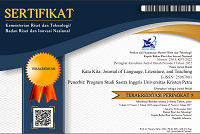Perceived Meanings by Women and Men in “Identical Twins and Best Friends” Olay Advertisement
DOI:
https://doi.org/10.9744/katakita.5.2.18-26Abstract
This study observes the perceived meanings produced by women and men as respondents from different gender group can produce different perceived meanings. Using process of signification, the study of myth and decoding, the writer analyzed how meanings are perceived in Olay “Identical Twins And Best Friends” video commercial. The study uses descriptive qualitative approach. The finding is that in perceiving, women respondents are more likely to relate the women in the video with themselves about beauty, their own experience, and relationship with their sisters; while men respondents are most likely to relate them with their ideal type of women, older people and other female friends. Through this study, the writer expects that the result will help the readers understand the influence of gender in perceiving meanings from an advertisement.References
Barthes, R. (1987). Mythologies. New York: Hill & Wang
Chandler, D. (2007). Semiotics The Basics (2nd ed). London: Routledge.
Hall, Stuart. (1980): 'Encoding/decoding'. In Centre for Contemporary Cultural
Studies (Ed.): Culture, Media, Language: Working Papers in Cultural
Studies, 1972-79 London: Hutchinson, pp. 128-38
Olay North America (2014, October 15). Identical Twins and Best
Friends|OlayPro-X. Retrieved February 22, 2017, from https://www.youtube.com/watch?v=c8bq0tHPCkA
PT. Unilever, Tbk. (2017). The Dove® Campaign for Real Beauty. Retrieved
March 17, 2017 from http://www.dove.com/us/en/stories/about-dove/our-
research.html
Schreier, M. (2012). Qualitative Content Analysis in Practice. Los Angeles:
SAGE Publications.
Swami, V. et.al. (2010, November 6). More than just skin deep? Personality Information Influences Men’s Ratings of the Attractiveness of Women’s Body Sizes. The Journal of Social Psychology., 150 (6), 628-647. Retrieved June 16, 2017 from http://www.tandfonline.com/doi/abs/10.1080/00224540903365497
Downloads
Issue
Section
License
Authors who publish with this journal agree to the following terms:- Authors retain copyright and grant the journal right of first publication with the work simultaneously licensed under a Creative Commons Attribution License that allows others to share the work with an acknowledgement of the work's authorship and initial publication in this journal.
- Authors are able to enter into separate, additional contractual arrangements for the non-exclusive distribution of the journal's published version of the work (e.g., post it to an institutional repository or publish it in a book), with an acknowledgement of its initial publication in this journal.
- Authors are permitted and encouraged to post their work online (e.g., in institutional repositories or on their website) prior to and during the submission process, as it can lead to productive exchanges, as well as earlier and greater citation of published work (See The Effect of Open Access).














